Construction of Multi-Channel Teaching Effect Evaluation System Based on Deep Learning in the Era of Education Informatization
Data publikacji: 26 wrz 2025
Otrzymano: 29 sty 2025
Przyjęty: 30 kwi 2025
DOI: https://doi.org/10.2478/amns-2025-1085
Słowa kluczowe
© 2025 Jing Ma et al., published by Sciendo
This work is licensed under the Creative Commons Attribution 4.0 International License.
“Internet+” has brought a series of significant changes in methods and modes of education as well as a revolution in the concept of education [1]. Compared with the traditional face-to-face lectures between teachers and students, online classroom teaching relying on the Internet is not limited by time and space, and this kind of teaching method allows both teachers and students to freely arrange the time and place of lectures [2-4]. Teachers can use multi-channel information technology to teach the same content as traditional face-to-face courses in online classroom teaching, and also allow students to search through the Internet to find supplemental content of the latest subject knowledge at any time in the online classroom [5-7]. Channel is a way of transferring information, which is an indispensable element in the process of verbal communication [8]. The use of multichannel linkage such as recording, live broadcasting and real-time communication during online classes can more fully mobilize students’ learning interest and participation [9-11]. In the multi-channel teaching mode, students can also use screenshots and other methods to record notes, thus completing the course learning process more conveniently and quickly [12-14]. The use of informative teaching methods helps to improve the quality and efficiency of online classroom teaching.
The use of artificial intelligence to carry out the analysis of student learning behavior and evaluation of teaching effectiveness is of great significance in changing the teaching method [15]. The use of artificial intelligence technology to carry out teaching evaluation can analyze and evaluate the learning process and results, and provide a scientific basis for teaching decisions [16]. Carrying out student learning behavior analysis using intelligent education with the deep integration of artificial intelligence and educational learning mainly relies on computer vision, deep learning and other technologies and algorithms to intelligently identify and count the interactive classroom learning behaviors of students in the video [17-19]. Then classroom teaching effect evaluation is carried out according to the statistics and distribution of learning behavior, which can well solve the evaluation problem of classroom teaching effect, and at the same time can effectively promote the traditional classroom learning in the direction of informatization and intelligence [20-23]. Deep learning can automatically acquire the method of model features and integrate feature learning into the process of model building, thus reducing the incompleteness caused by human-designed features [24-26]. Currently, some applications centered on deep learning have achieved recognition or classification performance beyond existing algorithms in application scenarios that meet specific conditions [27-28]. Deep learning technology is used to analyze and count the students’ learning behaviors and establish teaching effect evaluation models in order to realize the evaluation of teaching effect and ultimately improve the classroom teaching effect.
This paper designs a complete set of teaching evaluation system with 12 secondary evaluation indexes for multi-channel teaching effect evaluation, and in order to realize the innovation of teaching evaluation method, an optimized particle swarm algorithm is designed from the improvement of inertia weights and the improvement of learning factors. The optimized particle swarm algorithm is used to optimize the center of the activation function of the intermediate hidden layer of the RBF neural network, the width of the nodes in the hidden layer and the connection weights in the output layer, so as to complete the construction of the multi-channel teaching evaluation model based on the particle swarm algorithm. The designed model is used for simulation and practical application to complete the performance and effect verification of the model.
The background evaluation of multi-channel teaching mainly evaluates the rationality of the teaching objectives, and it can try to explore the problems by analyzing whether the teaching objectives are set in line with the current social needs and professional training objectives, and the ability of teachers and students to prepare for them, etc., and ultimately determine whether the objectives of multi-channel teaching are set reasonably, and evaluate the environmental basis of the quality of multi-channel teaching. Teachers and students need to have certain information quality and be able to use computers, tablets, cell phones and other devices to log into the platform in order to complete online teaching and other teaching activities. At the same time, multi-channel teaching also needs to be in line with the objectives of teaching and training, which is the background environment for the development of multi-channel teaching. According to the guiding ideology of “output-oriented”, the needs of economic and social development should be reflected in the index design, and the “goal setting” should be taken as the secondary index, so as to give full play to the role of the “baton” of teaching quality evaluation, guide the scientific and reasonable setting of training goals, and effectively improve the goal achievement and social adaptability of talent training with the improvement of teaching quality. Highlight and strengthen the “student center”, and take “student ability” as the secondary indicator of background evaluation. In the specific survey results, 90% of the experts agreed to use “goal setting”, “teacher ability” and “student ability” as the secondary indicators of “background evaluation”.
The input evaluation of multi-channel teaching can evaluate the feasibility of the quality of multi-channel teaching by analyzing whether the teaching facilities, faculty, and lesson plans are accurate and in place, and by predicting the risks that may arise in the implementation of the teaching program, so as to choose a practical teaching program. Multi-channel teaching requires a suitable online teaching platform to carry out teaching activities, and also requires sufficient faculty to develop and integrate online and offline courses. Therefore, the investment in facilities, faculty and other resources will constrain whether multi-channel teaching activities can be carried out smoothly and whether the planned teaching programs are practicable or not. In the design of specific indicators, the teaching quality evaluation idea of “continuous improvement” is highlighted, and a quality assurance system for teaching work is established from the aspects of hardware facilities, teacher investment, and teaching preparation, so as to promote the continuous improvement of teaching quality through timely evaluation, timely feedback, and continuous improvement. 80% of the experts agreed that the investment indicators of multi-channel teaching should be evaluated from three aspects: “facility resources”, “teachers” and “curriculum preparation”.
The process evaluation of multi-channel teaching is a very important part, focusing on the performance of teachers and students in the implementation process of multi-channel teaching, which can effectively control the process of teaching implementation, timely monitoring, analysis, feedback and corrective action, and evaluate the controllability of the quality of multi-channel teaching In traditional teaching, the teacher is the main body, and the students are only passive to accept the knowledge, while in multi-channel teaching, the students are the main body, and through the Expanding the development of thinking to mobilize students’ initiative and enthusiasm, not only learning textbook knowledge, but also information, Internet and other qualities of training. Under the guidance of the idea of “student-centered” teaching quality evaluation, the process evaluation of multi-channel teaching should also emphasize the evaluation of students’ performance and the implementation of teaching programs on the basis of traditional teaching quality evaluation. 85% of the experts agreed that “teacher performance”, “student performance” and “program implementation” could be used as secondary indicators for multi-channel teaching process evaluation.
Outcome evaluation evaluates the effectiveness of multi-channel teaching quality by assessing the implementation of the teaching plan, the enrichment of teaching results, and the sustainability and generalizability of the teaching program, focusing on the degree of impact of teaching activities on students, and providing information feedback for teachers and students. The tracking and evaluation of students’ learning effects is an important connotation of teaching quality evaluation and an important dimension of the evaluation index system. In the specific findings, all the experts unanimously agreed to analyze the outcome evaluation from the three dimensions of “teacher development”, “student growth” and “overall effect”. The study finally formed a multi-channel teaching evaluation index system with 4 primary indicators and 12 secondary indicators, as shown in Table 1.
Channel teaching evaluation index system
| Primary indicator | Secondary indicator |
|---|---|
| Background evaluation | Target setting |
| Faculty | |
| Student capacity | |
| Input evaluation | Facility resources |
| Teacher reserve | |
| Course preparation | |
| Process evaluation | Teacher performance |
| Student performance | |
| Programme implementation | |
| Result evaluation | Teacher development |
| Student growth | |
| Overall effect |
Particle Swarm Algorithm (PSO) [29] is an evolutionary computation, an iterative optimization tool similar to genetic algorithms. The particle swarm algorithm simulates the feeding behavior of birds. You can imagine a scenario where a flock of birds randomly search for food. In this area, there is only one type of food, however, all the birds do not know where the food is, but they know exactly the distance before they get to the food. How can an optimal foraging strategy be formed? The current simpler and more effective method is to search for food from the area around the bird’s food. Particle swarm algorithms take their cue from the model to solve such problems. Each optimization is designed to search for a bird in space called a “particle”. All particles have fitness values determined by the optimization function, and each particle also has a velocity to determine direction and distance. The particles then follow the optimized particles in searching the swarm as a random particle (random solution), using an iterative approach to find the optimal solution. In each iteration, the particle updates itself by following two “extreme” particles. The first is the optimal solution found by the particle. This type of solution is called PBest [30], and the other approach is to find the optimal by species. This type of solution is called the global extreme.
When these two optimal solutions are found, the particle performs a self-update to localize its velocity and position via Eq. (1) and Eq. (2).
where
A radial basis function is a real-valued function whose value depends only on the distance to the origin, hence
Radial basis functions are typically used to build functions of the form:
The result of the computation of this approximation function
There are three learning parameters: the RBF centers Select a series from the input matrix Compute the variance:
where Calculate Update the RBF parameters [31].
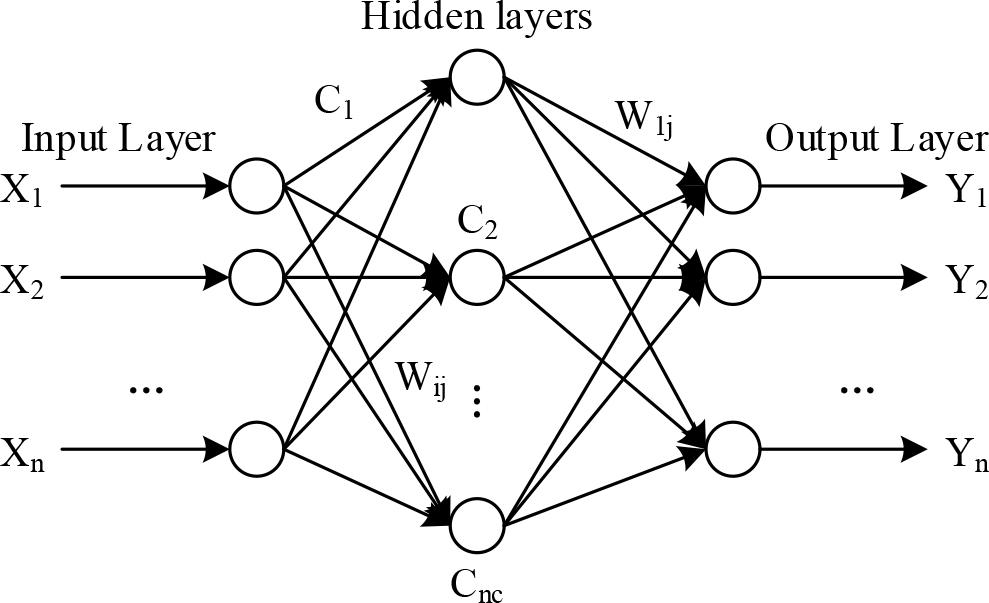
RBF neural network structure
where If the network converges, stop the computation, otherwise go to step (3).
Through the model analysis of the basic particle swarm optimization algorithm, it is known that the value of inertia weight
In Eq. (11), denotes the number of iterations, and
The learning factor can regulate the proportion of individual cognition and group cognition in the optimization process of particles. The speed of individual extremes is regulated by learning factor
Where,
The basic idea of the improved PSO-RBF neural network control algorithm is to regard all the radial basis function centers, widths and connection weights in the RBF neural network as moving particles, that is, to write these three parameters as a vector in turn, which is equivalent to the position vector of the particles, and to optimize these particles through the improved particle swarm optimization algorithm, so as to obtain suitable network parameters and avoid the adverse consequences caused by improper parameter selection. These optimized parameters are then used to build an RBF neural network, which can improve the control effect of the network and enable the model to obtain better results in the evaluation of the effectiveness of multi-channel teaching.
The standard Gaussian function is chosen as the activation function of the neural network, thus the specific expression of the
Select a function as the fitness function of the particle swarm algorithm, before each iteration, the fitness function value of each particle should be calculated, combined with the specific circumstances of the optimization search, this paper selects the mean square error as the fitness function of the algorithm, the calculation method is as follows:
Where
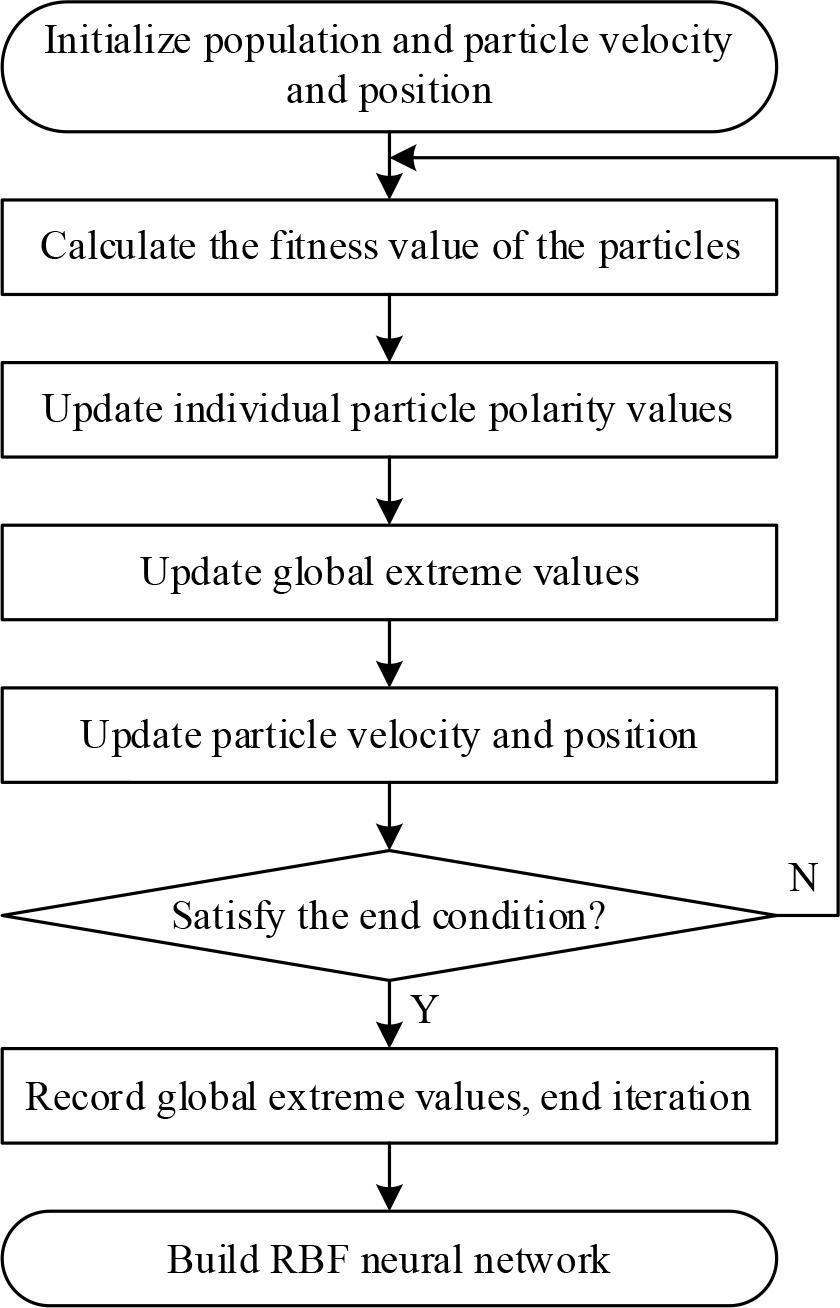
Improves the pso algorithm to optimize the RBF network framework
The operation procedure of the improved PSO-RBF neural network control algorithm is as follows:
Step 1: The three parameters of the RBF neural network, center value, width and connection weights, are sequentially combined to form a particle vector in the PSO algorithm, where each particle position consists of the center
Step 2: Calculate the fitness value of the particle.
Step 3: Update the particle’s individual extreme value
Step 4: Update the global poles of the population
Step 5: Update the position and velocity of the particle. Update the position and velocity of the particle according to the update formula.
Step 6: Judge the end condition, judge whether to end the iteration according to the set end condition, if it is satisfied, go to the next step, otherwise return to step 2 and iterate again.
Step 7: Record the found global extreme value and end the PSO algorithm.
Step 8: Construct an RBF neural network using the global extreme values and train the network.
Apply the above trained network to the task of evaluating the effectiveness of multi-channel teaching.
In order to verify the effectiveness of the proposed algorithm, teaching effect prediction experiments are conducted on the improved PSO-RBF neural network. In order to test the performance of the improved PSO-RBF algorithm, the performance of the improved PSO-RBF algorithm is compared with that of the GA-RBF algorithm and the APSO-RBF algorithm, and the number of neurons, the training RMSE, the testing RMSE, the training time and the testing time are used as the comprehensive evaluation indexes, respectively, and the algorithms are run independently for 30 times, and the results of the experiments are taken as the average value. The teaching data provided by a university is used for simulation experiments.
Using the historical data of classroom teaching in the university in the first week of March 2020 from Monday to Friday, 500 sets of data were obtained after data preprocessing, the first 400 sets of data were selected to train the model, and the last 100 sets of data’s were used for testing, and the C-C method was used to determine that the embedding position and the delay time were both 4, and to establish the evaluation model. There are four input variables for this experiment, the initial number of neurons in the hidden layer is set to 4, so that the maximum upper limit is 15, the lower limit is 3, the maximum number of iterations is 4000, and the parameters of the target model are set as follows: the number of population particles is 100. Threshold parameters 0.45th, 0.0005th. The number of elite knowledge is: 10. The number of elite particle reverse learning is: 10. Learning rate 0.5. The training results and training errors of the proposed algorithm and the comparison algorithm in solving the teaching effect prediction problem are given in Fig. 3 and Fig. 4, respectively, which show that compared with other improved algorithms, the training error of the proposed improved PSO-RBF algorithm fluctuates within a very small range, and the actual output can track the desired output better. Fig. 5 and Fig. 6 give the test results and test errors of the proposed algorithm and the comparison algorithm, respectively, the proposed algorithm’s error fluctuates in a small range, and the actual output still has a high degree of fit with the desired output, which indicates that the network model proposed in this paper is effective in the prediction of teaching effect and has a high prediction accuracy. Figure 7 shows the process of automatic adjustment of neurons in the hidden layer of the algorithm, and it can be seen that the number of neurons in the hidden layer of the improved PSO-RBF neural network can be dynamically adjusted with the change of the number of iterations of the algorithm to ensure the generalization ability of the network.
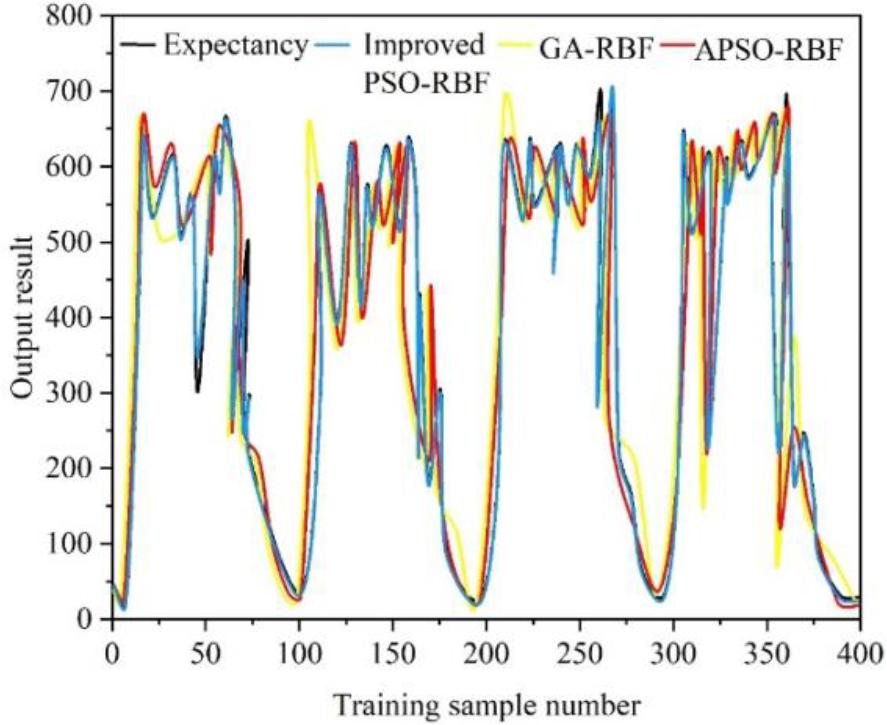
Comparison of the sample output results of different algorithms
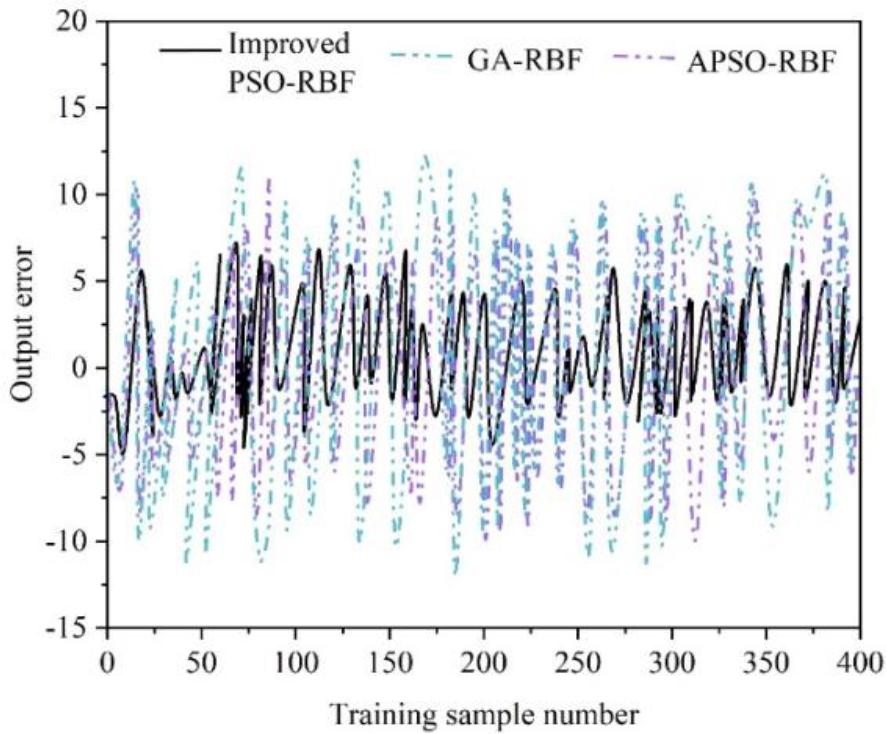
Different algorithm training sample output error contrast

Comparison of test sample output of different algorithms
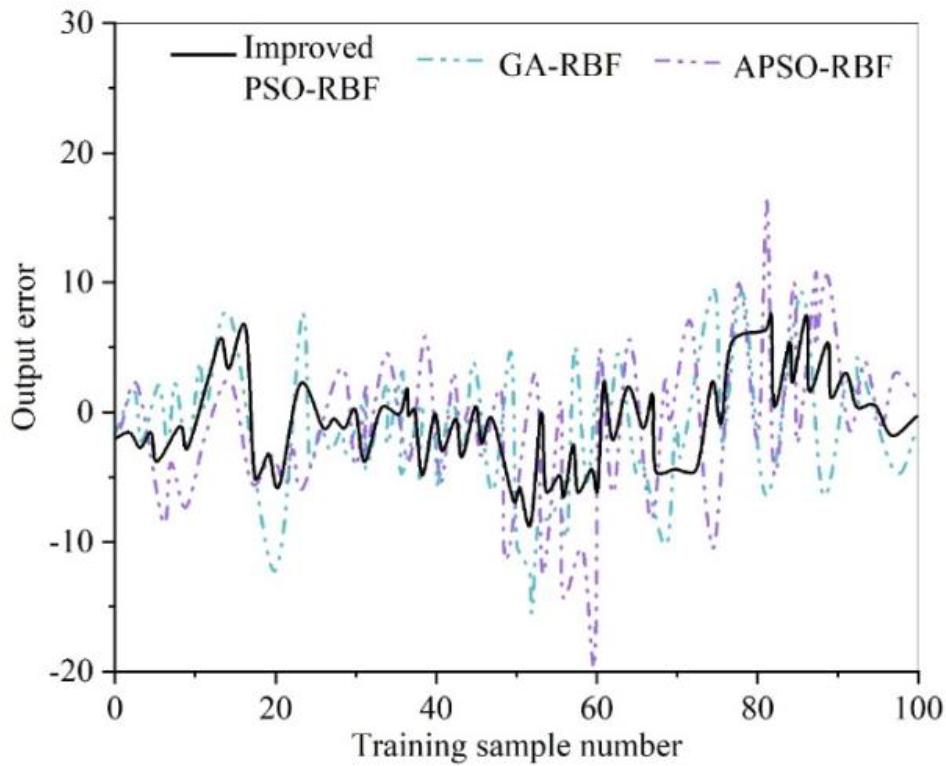
Test sample output error comparison of different algorithms
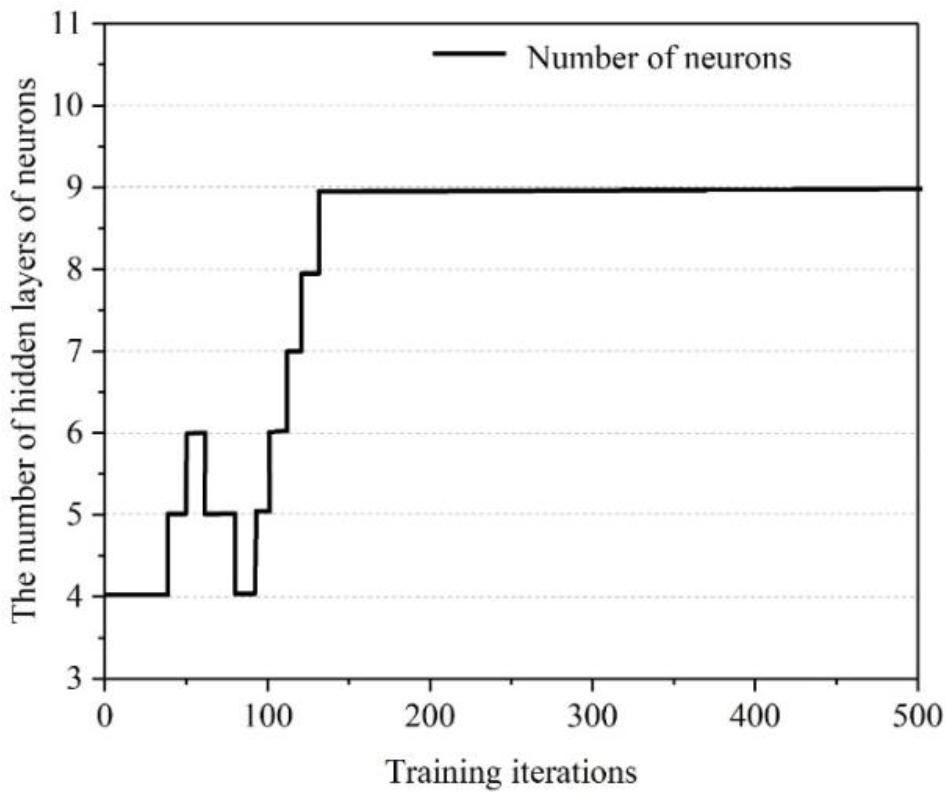
The number of neurons in the hidden layer is adjusted
Through the teaching effect prediction experiments, it can be seen that the proposed improved PSO-RBF neural network can effectively predict the teaching effect with high prediction accuracy. In order to further verify the performance of the proposed algorithm, Table 2 lists the prediction performance indicators of different algorithms for teaching effect, including training RMSE, testing RMSE, network structure size, training time and testing time, and it can be seen by comparing the results of the experiments that the proposed teaching effect evaluation model based on the improved PSO-RBF neural network has the smallest testing RMSE of 7.0128, the most compact structure, and the hidden layer neuron is only 7.0128, which is also the most compact, and the structure is only the most compact. The structure is also the most compact, and the number of neurons in the hidden layer is only 9, indicating the highest prediction accuracy.
Comparison of performance indicators of different algorithms
| Algorithm | Training error (RMSE) | Test error (RMSE) | The number of hidden layers of neurons | Training time/s | Test time/s |
|---|---|---|---|---|---|
| GA-RBF | 10.7415 | 10.9745 | 12 | 955.4 | 0.0033 |
| APSO-RBF | 8.1544 | 8.1145 | 11 | 914.2 | 0.0032 |
| Improved PSO-RBF | 7.0025 | 7.0128 | 9 | 905.1 | 0.0028 |
In this paper, the input data for information collection is obtained by adopting the method of online evaluation of teaching by students. For the desired output indicators, this paper takes the comprehensive ratings of school supervisors and experts on several courses after listening to the lectures, and the training data are selected from the ratings of students attending the classes, the significance of which lies in the fact that although the various indicators of the courses are typed out by the students, the final evaluation results obtained by the network training learn to simulate the evaluation ideas of supervisors and experts.
Regarding the sample data needed for RBF network training, the specific method of questionnaire distribution to students was adopted to obtain. The object of evaluation is the effectiveness of multi-channel teaching in a certain course. First of all, one course is selected from each level of the courses evaluated by the experts, five courses in total, and then the questionnaire is distributed to the students, and the specific design of the questionnaire is that each evaluation indicator (question) includes five options of “agree, agree, generally, disagree, disagree very much”, and the scores are respectively “4, 3, 2, 1, 0”, each student is allowed to choose only one item for each indicator.
Let the number of questionnaires for the five courses be N1, N2, N3, N4, N5, and each questionnaire is 1 training sample. The purpose of collecting these data is to use them to train the RBF network so that it “learns” the complex nonlinear mapping relationship between the evaluation indexes of each course and its corresponding evaluation level. The purpose of training is the future application.
In this paper, six courses participating in the teaching reform, namely 3D Animation Design and Production, Outline of Modern Chinese History, Health Education for College Students, Gemstone Appreciation, Ethnic Music Appreciation, and Art Appreciation for College Students, were selected from a private college during the academic year of 2016-2017, and sample data were obtained by distributing questionnaires on their multi-channel teaching effects, and then the sample data of the first five courses were used to train an RBF network to “learn” the evaluation indexes of each course and their corresponding evaluation levels. Sample data to train the RBF network, using the trained network on the teaching reform effect of “Art Appreciation for College Students”, to test and evaluate, in order to examine the effectiveness of the method of this paper. The number of questionnaires issued for the six courses and the evaluation results given by experts are shown in Table 3.
The number of questionnaires and the results of experts’ evaluation
| Course name | Questionnaire distribution | Expert evaluation results |
|---|---|---|
| 3D animation design and production | 100 | Excellence |
| China modern history | 100 | Good |
| College students mental health education | 100 | Medium |
| Gem appreciation | 100 | Qualify |
| National music appreciation | 100 | Out of line |
| College students’ artistic appreciation | 100 | Good |
| Tot | 600 |
Based on the above methodology, we kept detailed records of all the questionnaires of the six courses, which in turn yielded all the 600 sample statistics, of which the first 500 were used for the training of the RBF network, and the last 100 were used for the testing of the network’s generalization ability.
In order to facilitate the RBF network training, the qualitative evaluation results given by the experts need to be quantified into numerical-type results that can be handled by the RBF network. According to the experience of experts and the actual situation of multi-channel teaching effect, the evaluation results are divided into five grades, which are “excellent, good, medium, qualified, unqualified”. The value range of each grade is 0.90~1.00, 0.80~0.89, 0.70~0.79, 0.60~0.69, 0.59 or less, and we take the median value of each evaluation grade as the quantitative result of the grade, which is in fact the expected output of the sample. Part of the sample data is shown in Table 4.
According to the questionnaire obtained
| Courses | Serial number | Evaluation index | Evaluation grade | Quantitative result | ||||
|---|---|---|---|---|---|---|---|---|
| X1 | X2 | X3 | …… | X12 | ||||
| 3D animation design and production | 1 | 3 | 4 | 3 | …… | 3 | Excellence | 0.95 |
| 2 | 4 | 4 | 3 | …… | 3 | Excellence | 0.95 | |
| 3 | 4 | 3 | 3 | …… | 4 | Excellence | 0.95 | |
| …… | …… | …… | …… | …… | …… | …… | …… | |
| 100 | 3 | 3 | 4 | …… | 3 | Excellence | 0.95 | |
| China modern history | 1 | 4 | 3 | 3 | …… | 3 | Good | 0.85 |
| 2 | 4 | 4 | 3 | …… | 3 | Good | 0.85 | |
| 3 | 3 | 4 | 4 | …… | 3 | Good | 0.85 | |
| …… | …… | …… | …… | …… | …… | …… | …… | |
| 100 | 3 | 4 | 3 | …… | 4 | Good | 0.85 | |
| College students mental health education | 1 | 2 | 2 | 3 | …… | 3 | Medium | 0.75 |
| 2 | 3 | 3 | 2 | …… | 2 | Medium | 0.75 | |
| 3 | 3 | 3 | 3 | …… | 2 | Medium | 0.75 | |
| …… | …… | …… | …… | …… | …… | …… | …… | |
| 100 | 2 | 3 | 2 | …… | 2 | Medium | 0.75 | |
| Gem appreciation | 1 | 1 | 1 | 2 | …… | 1 | Qualify | 0.65 |
| 2 | 1 | 1 | 2 | …… | 2 | Qualify | 0.65 | |
| 3 | 1 | 1 | 1 | …… | 2 | Qualify | 0.65 | |
| …… | …… | …… | …… | …… | …… | …… | …… | |
| 100 | 2 | 2 | 2 | …… | 1 | Qualify | 0.65 | |
| National music appreciation | 1 | 1 | 0 | 1 | …… | 1 | Out of line | 0.3 |
| 2 | 1 | 1 | 0 | …… | 1 | Out of line | 0.3 | |
| 3 | 1 | 0 | 0 | …… | 0 | Out of line | 0.3 | |
| …… | …… | …… | …… | …… | …… | …… | …… | |
| 100 | 0 | 0 | 1 | …… | 0 | Out of line | 0.3 | |
| College students’ artistic appreciation | 1 | 4 | 3 | 2 | …… | 3 | Good | 0.85 |
| 2 | 4 | 2 | 2 | …… | 4 | Good | 0.85 | |
| 3 | 4 | 3 | 3 | …… | 3 | Good | 0.85 | |
| …… | …… | …… | …… | …… | …… | …… | …… | |
| 100 | 4 | 3 | 2 | …… | 2 | Good | 0.85 | |
Firstly, suitable data samples are selected, and before the data samples are input to the RBF network, the data are normalized. In this study, the maximum and minimum value method is selected to normalize the data samples, because this method belongs to a linear transformation of the data, which can better retain the originality of the data, and will not cause the distortion of the data information.
The input and output data are normalized to a value between [0, 1], and the transformation formula is entered as follows:
Where,
Firstly, the topology of the network is determined, and secondly, the network parameters are initialized. There are two types of network parameters for RBF, the first type is the center and variance of the radial basis function nodes in the hidden layer, and the second type is the output layer weights. Both types of parameters need to set initial values before using
The basic idea of the
Initialize: number of clusters Calculate the new center If
Link to for this paper’s problem, obviously the number of classes
The variance was determined using the following empirical formula.
500 sample data from the first five courses were submitted to the RBF network for training to approximate the complex mapping relationship between the evaluation metrics and various evaluation outcomes. The network converged after 3400 iteration steps. The dynamic curve of the approximation error decreasing with the number of iteration steps is shown in Fig. 8.
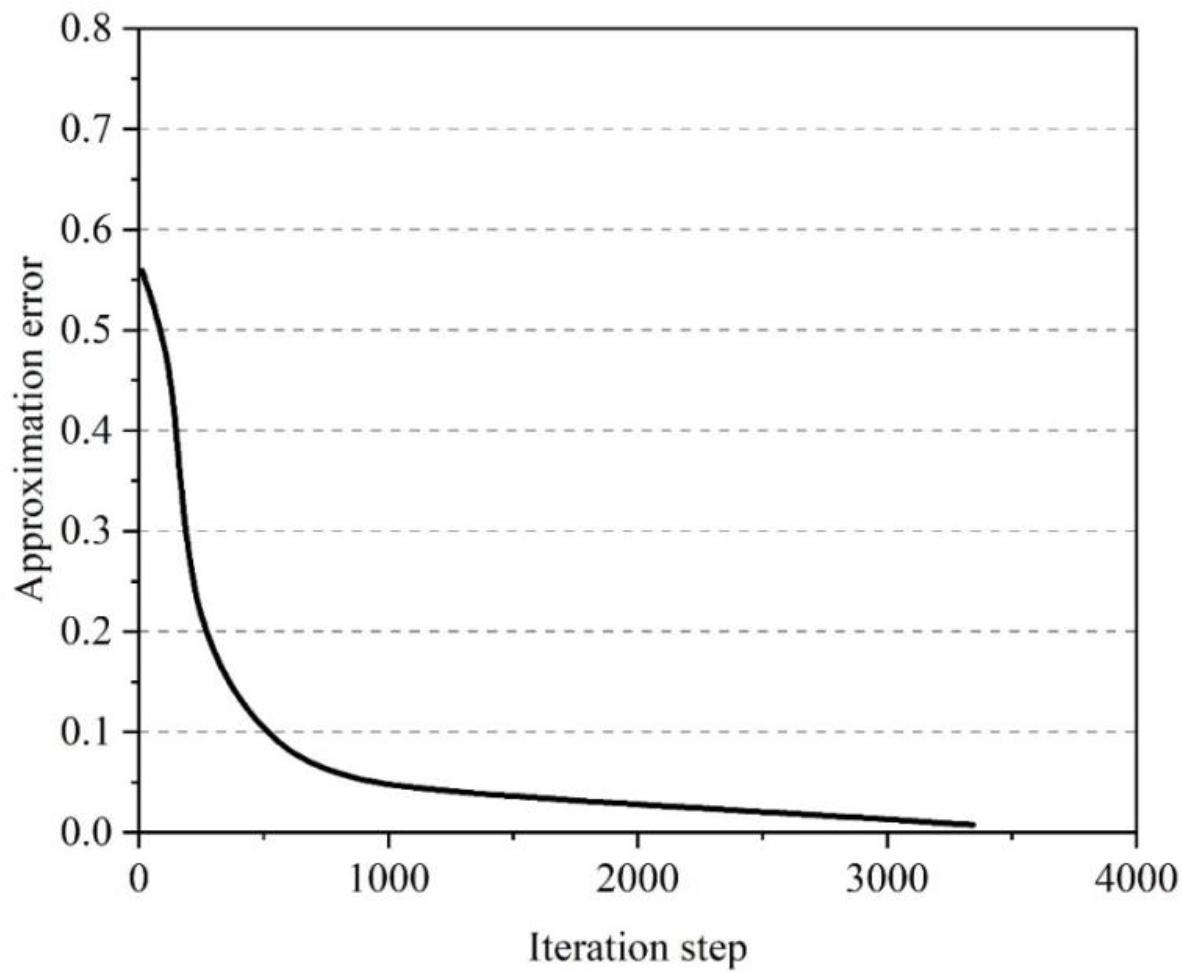
The dynamic curve of the approximation error
Since the output of the network is a real number, the quantitative numerical results need to be transformed into qualitative evaluation grades. Let the numerical result of the output of the
Sample training results
| Courses | Serial number | Actual output | Expected output | Training results | Expert outcome |
|---|---|---|---|---|---|
| 3D animation design and production | 1 | 0.9546 | 0.95 | Excellence | Excellence |
| 2 | 0.9544 | 0.95 | Excellence | Excellence | |
| 3 | 0.9465 | 0.95 | Excellence | Excellence | |
| …… | …… | …… | …… | …… | |
| 100 | 0.9544 | 0.95 | Excellence | Excellence | |
| China modern history | 1 | 0.8518 | 0.85 | Good | Good |
| 2 | 0.8541 | 0.85 | Good | Good | |
| 3 | 0.8501 | 0.85 | Good | Good | |
| …… | …… | …… | …… | …… | |
| 100 | 0.8499 | 0.85 | Good | Good | |
| College students mental health education | 1 | 0.7505 | 0.75 | Medium | Medium |
| 2 | 0.7501 | 0.75 | Medium | Medium | |
| 3 | 0.7455 | 0.75 | Medium | Medium | |
| …… | …… | …… | …… | …… | |
| 100 | 0.7526 | 0.75 | Medium | Medium | |
| Gem appreciation | 1 | 0.6542 | 0.65 | Qualify | Qualify |
| 2 | 0.6463 | 0.65 | Qualify | Qualify | |
| 3 | 0.6526 | 0.65 | Qualify | Qualify | |
| …… | …… | …… | …… | …… | |
| 100 | 0.6514 | 0.65 | Qualify | Qualify | |
| National music appreciation | 1 | 0.3112 | 0.3 | Out of line | Out of line |
| 2 | 0.2981 | 0.3 | Out of line | Out of line | |
| 3 | 0.3021 | 0.3 | Out of line | Out of line | |
| …… | …… | …… | …… | …… | |
| 100 | 0.2931 | 0.3 | Out of line | Out of line |
In the following, we examine the generalization and promotion ability of the validated trained RBF network. The 100 samples from the course “Art Appreciation for College Students”, which was not used in the training phase, were used to test the trained RBF network, and the evaluation results of some samples are shown in Table 6.
Sample training results
| Courses | Serial number | Actual output | Expected output | Training results | Expert outcome |
|---|---|---|---|---|---|
| College students’ artistic appreciation | 1 | 0.8541 | 0.85 | Good | Good |
| 2 | 0.8564 | 0.85 | Good | Good | |
| 3 | 0.8451 | 0.85 | Good | Good | |
| …… | …… | …… | …… | …… | |
| 100 | 0.8459 | 0.85 | Good | Good |
Among all 100 test samples, the maximum test error is 0.0525, in which 94 samples are judged correctly, 5 samples are judged excellent, and 3 samples are judged moderate. Thus the evaluation of RBF network is correct up to 94%. The validation results show that the improved RBF neural network and in multi-channel teaching effect evaluation model proposed in this paper has strong generalization and promotion ability, and is a feasible and reasonable evaluation model, thus providing a new way to solve the problem of comprehensive evaluation of multi-channel teaching effect in colleges and universities.
In this paper, the particle swarm algorithm is improved, and the improved particle swarm algorithm is combined with the RBF neural network, so as to design a multi-channel teaching effect assessment model based on the improved PSO-RBF algorithm.
Based on the improved PSO-RBF neural network multi-channel teaching effect evaluation model, simulation experiments on the actual multi-channel teaching effect evaluation were conducted. The experimental results show that the proposed improved PSO-RBF neural network control algorithm can evaluate the teaching effect with high accuracy. Compared with other models, the model proposed in this paper has higher accuracy and more compact network structure, and its test RMSE is the smallest, only 7.0128, and the number of neurons in the hidden layer is 9, which makes it more feasible and superior in the problem of multi-channel teaching effect evaluation.
Based on the multi-channel teaching effect assessment index system established in this paper with two levels and a total of 12 indexes, relevant experiments were designed to reveal the effectiveness of this paper’s model in practical application. In the 100 test samples of the course “Art Appreciation for College Students”, the maximum test error of this paper’s model is 0.0525, of which 94 samples are judged correctly and only 6 samples are tested incorrectly. The assessment correct rate of RBF network in this paper reaches 94%. It shows that the establishment of the multi-channel teaching assessment model in this paper provides a new way to objectively and fairly evaluate the effectiveness of multi-channel teaching.
